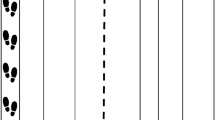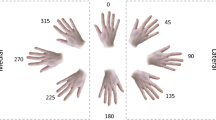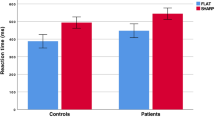Abstract
Motor imagery is a mental process during which subjects internally simulate a movement without any motor output. Mental and actual movement durations are similar in healthy adults (isochrony) while temporal discrepancies (anisochrony) could be an expression of neurological deficits on action representation. It is unclear whether patients with multiple sclerosis (PwMS) preserve the capacity to simulate their own movements. This study investigates the ability of PwMS to predict their own actions by comparing temporal features of dominant and non-dominant actual and mental actions. Fourteen PwMS and nineteen healthy subjects (HS) were asked to execute and to imagine pointing arm movements among four pairs of targets of different sizes. Task duration was calculated for both actual and mental movements by an optoelectronic device. Results showed temporal consistency and target-by-target size modulation in actual movements through the four cycles for both groups with significantly longer actual and mental movement durations in PwMS with respect to HS. An index of performance (IP) was used to examine actual/mental isochrony properties in the two groups. Statistical analysis on IP showed in PwMS significantly longer actual movement durations with respect to mental movement durations (anisochrony), more relevant for the non-dominant than dominant arm. Mental prediction of motor actions is not well preserved in MS where motor and cognitive functional changes are present. Differences in performing imagined task with dominant and non-dominant arm could be related to increased cognitive effort required for performing non-dominant movements.


Similar content being viewed by others
References
Arrondo G, Alegre M, Sepulcre J, Iriarte J, Artieda J, Villoslada P (2009) Abnormalities in brain synchronization are correlated with cognitive impairment in multiple sclerosis. Mult Scler 15(4):509–516
Avanzino L, Giannini A, Tacchino A, Pelosin E, Ruggeri P, Bove M (2009) Motor imagery influences the execution of repetitive finger opposition movements. Neurosci Lett 466(1):11–15
Baeck JS, Kim YT, Seo JH, Ryeom HK, Lee J, Choi SM, Woo M, Kim W, Kim JG, Chang Y (2012) Brain activation patterns of motor imagery reflect plastic changes associated with intensive shooting training. Behav Brain Res 234(1):26–32
Bakker M, de Lange FP, Stevens JA, Toni I, Bloem BR (2007) Motor imagery of gait: a quantitative approach. Exp Brain Res 179(3):497–504
Benedict RH, Carone DA, Bakshi R (2004a) Correlating brain atrophy with cognitive dysfunction, mood disturbances, and personality disorder in multiple sclerosis. J Neuroimaging 14(3 Suppl):36S–45S
Benedict RH, Weinstock-Guttman B, Fishman I, Sharma J, Tjoa CW, Bakshi R (2004b) Prediction of neuropsychological impairment in multiple sclerosis: comparison of conventional magnetic resonance imaging measures of atrophy and lesion burden. Arch Neurol 61(2):226–230
Benedict RH, Holtzer R, Motl RW, Foley FW, Kaur S, Hojnacki D, Weinstock-Guttman B (2011) Upper and lower extremity motor function and cognitive impairment in multiple sclerosis. J Int Neuropsychol Soc 17(4):643–653
Bergendal G, Fredrikson S, Almkvist O (2007) Selective decline in information processing in subgroups of multiple sclerosis: an 8-year longitudinal study. Eur Neurol 57(4):193–202
Bodling AM, Denney DR, Lynch SG (2009) Cognitive aging in patients with multiple sclerosis: a cross-sectional analysis of speeded processing. Arch Clin Neuropsychol 24(8):761–767
Bohannon RW, Smith MB (1987) Interrater reliability of a modified Ashworth scale of muscle spasticity. Phys Ther 67(2):206–207
Bonzano L, Tacchino A, Roccatagliata L, Abbruzzese G, Mancardi GL, Bove M (2008) Callosal contributions to simultaneous bimanual finger movements. J Neurosci 28(12):3227–3233
Bonzano L, Tacchino A, Roccatagliata L, Mancardi GL, Abbruzzese G, Bove M (2011) Structural integrity of callosal midbody influences intermanual transfer in a motor reaction-time task. Hum Brain Mapp 32(2):218–228
Caeyenberghs K, Tsoupas J, Wilson PH, Smits-Engelsman BC (2009) Motor imagery development in primary school children. Dev Neuropsychol 34(1):103–121
Casadio M, Sanguineti V, Morasso P, Solaro C (2008) Abnormal sensorimotor control, but intact force field adaptation, in multiple sclerosis subjects with no clinical disability. Mult Scler 14(3):330–342
Chiaravalloti ND, DeLuca J (2008) Cognitive impairment in multiple sclerosis. The Lancet Neurology 7(12):1139–1151
Cho HY, Kim JS, Lee GC (2012) Effects of motor imagery training on balance and gait abilities in post-stroke patients: a randomized controlled trial. Clin Rehabil [Epub ahead of print]
Choudhury S, Charman T, Bird V, Blakemore SJ (2007) Development of action representation during adolescence. Neuropsychologia 45(2):255–262
Colorado RA, Shukla K, Zhou Y, Wolinsky JS, Narayana PA (2012) Multi-task functional MRI in multiple sclerosis patients without clinical disability. Neuroimage 59(1):573–581
Compston A, Coles A (2008) Multiple sclerosis. Lancet 372(9648):1502–1517
Courtine G, Papaxanthis C, Gentili R, Pozzo T (2004) Gait-dependent motor memory facilitation in covert movement execution. Brain Res Cogn Brain Res 22(1):67–75
Danckert J, Ferber S, Doherty T, Steinmetz H, Nicolle D, Goodale MA (2002) Selective, non-lateralized impairment of motor imagery following right parietal damage. Neurocase 8(3):194–204
Decety J (1996) Do imagined and executed actions share the same neural substrate? Brain Res Cogn Brain Res 3(2):87–93
Decety J, Jeannerod M (1995) Mentally simulated movements in virtual reality: does Fitts’s law hold in motor imagery? Behav Brain Res 72(1–2):127–134
Decety J, Jeannerod M, Prablanc C (1989) The timing of mentally represented actions. Behav Brain Res 34(1–2):35–42
DeLuca J, Chelune GJ, Tulsky DS, Lengenfelder J, Chiaravalloti ND (2004) Is speed of processing or working memory the primary information processing deficit in multiple sclerosis? J Clin Exp Neuropsychol 26(4):550–562
Demougeot L, Papaxanthis C (2011) Muscle fatigue affects mental simulation of action. J Neurosci 31(29):10712–10720
Denney DR, Lynch SG, Parmenter BA, Horne N (2004) Cognitive impairment in relapsing and primary progressive multiple sclerosis: mostly a matter of speed. J Int Neuropsychol Soc 10(7):948–956
Dominey P, Decety J, Broussolle E, Chazot G, Jeannerod M (1995) Motor imagery of a lateralized sequential task is asymmetrically slowed in hemi-Parkinson’s patients. Neuropsychologia 33(6):727–741
Fadiga L, Craighero L (2004) Electrophysiology of action representation. J Clin Neurophysiol 21(3):157–169
Fischer JS, Rudick RA, Cutter GR, Reingold SC (1999) The multiple sclerosis functional composite measure (MSFC): an integrated approach to MS clinical outcome assessment. National MS Society Clinical Outcomes Assessment Task Force. Mult Scler 5(4):244–250
Flachenecker P, Kumpfel T, Kallmann B, Gottschalk M, Grauer O, Rieckmann P, Trenkwalder C, Toyka KV (2002) Fatigue in multiple sclerosis: a comparison of different rating scales and correlation to clinical parameters. Mult Scler 8(6):523–526
Folstein MF, Folstein SE, McHugh PR (1975) “Mini-mental state”. A practical method for grading the cognitive state of patients for the clinician. J Psychiatr Res 12(3):189–198
Frak V, Paulignan Y, Jeannerod M (2001) Orientation of the opposition axis in mentally simulated grasping. Exp Brain Res 136(1):120–127
Gentili R, Cahouet V, Ballay Y, Papaxanthis C (2004) Inertial properties of the arm are accurately predicted during motor imagery. Behav Brain Res 155(2):231–239
Gentili R, Papaxanthis C, Pozzo T (2006) Improvement and generalization of arm motor performance through motor imagery practice. Neuroscience 137(3):761–772
Gentili R, Han CE, Schweighofer N, Papaxanthis C (2010) Motor learning without doing: trial-by-trial improvement in motor performance during mental training. J Neurophysiol 104(2):774–783
Gueugneau N, Mauvieux B, Papaxanthis C (2009) Circadian modulation of mentally simulated motor actions: implications for the potential use of motor imagery in rehabilitation. Neurorehabil Neural Repair 23(3):237–245
Helmich RC, de Lange FP, Bloem BR, Toni I (2007) Cerebral compensation during motor imagery in Parkinson’s disease. Neuropsychologia 45(10):2201–2215
Heremans E, Feys P, Nieuwboer A, Vercruysse S, Vandenberghe W, Sharma N, Helsen W (2011) Motor imagery ability in patients with early- and mid-stage Parkinson disease. Neurorehabil Neural Repair 25(2):168–177
Heremans E, D’Hooge A M, De Bondt S, Helsen W, Feys P (2012) The relation between cognitive and motor dysfunction and motor imagery ability in patients with multiple sclerosis. Mult Scler 18(3):1303–1309
Hong IK, Choi JB, Lee JH (2012) Cortical changes after mental imagery training combined with electromyography-triggered electrical stimulation in patients with chronic stroke. Stroke J Cereb Circ 43(9):2506–2509
Human Experimentation: Code of Ethics of the World Medical Association (Declaration of Helsinki) (1964) Can Med Assoc J 91(11):619
Jackson PL, Lafleur MF, Malouin F, Richards CL, Doyon J (2003) Functional cerebral reorganization following motor sequence learning through mental practice with motor imagery. Neuroimage 20(2):1171–1180
Janculjak D, Mubrin Z, Brinar V, Spilich G (2002) Changes of attention and memory in a group of patients with multiple sclerosis. Clin Neurol Neurosurg 104(3):221–227
Jeannerod M (2001) Neural simulation of action: a unifying mechanism for motor cognition. Neuroimage 14(1 Pt 2):S103–S109
Jeannerod M, Decety J (1995) Mental motor imagery: a window into the representational stages of action. Curr Opin Neurobiol 5(6):727–732
Johnson SH (2000) Imagining the impossible: intact motor representations in hemiplegics. NeuroReport 11(4):729–732
Johnson SH, Sprehn G, Saykin AJ (2002) Intact motor imagery in chronic upper limb hemiplegics: evidence for activity-independent action representations. J Cogn Neurosci 14(6):841–852
Kagerer FA, Bracha V, Wunderlich DA, Stelmach GE, Bloedel JR (1998) Ataxia reflected in the simulated movements of patients with cerebellar lesions. Exp Brain Res 121(2):125–134
Lee M, Reddy H, Johansen-Berg H, Pendlebury S, Jenkinson M, Smith S, Palace J, Matthews PM (2000) The motor cortex shows adaptive functional changes to brain injury from multiple sclerosis. Ann Neurol 47(5):606–613
Mainero C, Caramia F, Pozzilli C, Pisani A, Pestalozza I, Borriello G, Bozzao L, Pantano P (2004) fMRI evidence of brain reorganization during attention and memory tasks in multiple sclerosis. Neuroimage 21(3):858–867
Maruff P, Wilson PH, De Fazio J, Cerritelli B, Hedt A, Currie J (1999) Asymmetries between dominant and non-dominant hands in real and imagined motor task performance. Neuropsychologia 37(3):379–384
McDonald WI, Compston A, Edan G, Goodkin D, Hartung HP, Lublin FD, McFarland HF, Paty DW, Polman CH, Reingold SC, Sandberg-Wollheim M, Sibley W, Thompson A, van den Noort S, Weinshenker BY, Wolinsky JS (2001) Recommended diagnostic criteria for multiple sclerosis: guidelines from the international panel on the diagnosis of multiple sclerosis. Ann Neurol 50(1):121–127
Oldfield RC (1971) The assessment and analysis of handedness: the Edinburgh inventory. Neuropsychologia 9(1):97–113
Page SJ, Levine P, Leonard A (2007) Mental practice in chronic stroke: results of a randomized, placebo-controlled trial. Stroke J Cereb Circ 38(4):1293–1297
Papaxanthis C, Pozzo T, Skoura X, Schieppati M (2002) Does order and timing in performance of imagined and actual movements affect the motor imagery process? The duration of walking and writing task. Behav Brain Res 134(1–2):209–215
Papaxanthis C, Pozzo T, Kasprinski R, Berthoz A (2003) Comparison of actual and imagined execution of whole-body movements after a long exposure to microgravity. Neurosci Lett 339(1):41–44
Papaxanthis C, Paizis C, White O, Pozzo T, Stucchi N (2012) The relation between geometry and time in mental actions. PLoS ONE 7(11):e51191
Penner IK, Rausch M, Kappos L, Opwis K, Radu EW (2003) Analysis of impairment related functional architecture in MS patients during performance of different attention tasks. J Neurol 250(4):461–472
Personnier P, Paizis C, Ballay Y, Papaxanthis C (2008) Mentally represented motor actions in normal aging II. The influence of the gravito-inertial context on the duration of overt and covert arm movements. Behav Brain Res 186(2):273–283
Personnier P, Ballay Y, Papaxanthis C (2010a) Mentally represented motor actions in normal aging: III. Electromyographic features of imagined arm movements. Behav Brain Res 206(2):184–191
Personnier P, Kubicki A, Laroche D, Papaxanthis C (2010b) Temporal features of imagined locomotion in normal aging. Neurosci Lett 476(3):146–149
Ranganathan VK, Siemionow V, Liu JZ, Sahgal V, Yue GH (2004) From mental power to muscle power–gaining strength by using the mind. Neuropsychologia 42(7):944–956
Reddy H, Narayanan S, Arnoutelis R, Jenkinson M, Antel J, Matthews PM, Arnold DL (2000) Evidence for adaptive functional changes in the cerebral cortex with axonal injury from multiple sclerosis. Brain 123(Pt 11):2314–2320
Reicker LI, Tombaugh TN, Walker L, Freedman MS (2007) Reaction time: an alternative method for assessing the effects of multiple sclerosis on information processing speed. Arch Clin Neuropsychol 22(5):655–664
Rizzo MA, Hadjimichael OC, Preiningerova J, Vollmer TL (2004) Prevalence and treatment of spasticity reported by multiple sclerosis patients. Mult Scler 10(5):589–595
Rocca MA, Pagani E, Ghezzi A, Falini A, Zaffaroni M, Colombo B, Scotti G, Comi G, Filippi M (2003) Functional cortical changes in patients with multiple sclerosis and nonspecific findings on conventional magnetic resonance imaging scans of the brain. Neuroimage 19(3):826–836
Sharma N, Pomeroy VM, Baron JC (2006) Motor imagery: a backdoor to the motor system after stroke? Stroke J Cereb Circ 37(7):1941–1952
Simmons L, Sharma N, Baron JC, Pomeroy VM (2008) Motor imagery to enhance recovery after subcortical stroke: who might benefit, daily dose, and potential effects. Neurorehabil Neural Repair 22(5):458–467
Sirigu A, Duhamel JR, Cohen L, Pillon B, Dubois B, Agid Y (1996) The mental representation of hand movements after parietal cortex damage. Science 273(5281):1564–1568
Sirigu A, Cohen L, Zalla T, Pradat-Diehl P, Van Eeckhout P, Grafman J, Agid Y (1998) Distinct frontal regions for processing sentence syntax and story grammar. Cortex J Devot Study Nerv Syst Behav 34(5):771–778
Skoura X, Papaxanthis C, Vinter A, Pozzo T (2005) Mentally represented motor actions in normal aging. I. Age effects on the temporal features of overt and covert execution of actions. Behav Brain Res 165(2):229–239
Skoura X, Personnier P, Vinter A, Pozzo T, Papaxanthis C (2008) Decline in motor prediction in elderly subjects: right versus left arm differences in mentally simulated motor actions. Cortex J Devot Study Nerv Syst Behav 44(9):1271–1278
Skoura X, Vinter A, Papaxanthis C (2009) Mentally simulated motor actions in children. Dev Neuropsychol 34(3):356–367
Solaro C, Brichetto G, Casadio M, Roccatagliata L, Ruggiu P, Mancardi GL, Morasso PG, Tanganelli P, Sanguineti V (2007) Subtle upper limb impairment in asymptomatic multiple sclerosis subjects. Mult Scler 13(3):428–432
Staffen W, Mair A, Zauner H, Unterrainer J, Niederhofer H, Kutzelnigg A, Ritter S, Golaszewski S, Iglseder B, Ladurner G (2002) Cognitive function and fMRI in patients with multiple sclerosis: evidence for compensatory cortical activation during an attention task. Brain 125(Pt 6):1275–1282
Steens A, de Vries A, Hemmen J, Heersema T, Heerings M, Maurits N, Zijdewind I (2012a) Fatigue perceived by multiple sclerosis patients is associated with muscle fatigue. Neurorehabil Neural Repair 26(1):48–57
Steens A, Heersema DJ, Maurits NM, Renken RJ, Zijdewind I (2012b) Mechanisms underlying muscle fatigue differ between multiple sclerosis patients and controls: a combined electrophysiological and neuroimaging study. Neuroimage 59(4):3110–3118
Stinear CM, Byblow WD, Steyvers M, Levin O, Swinnen SP (2006) Kinesthetic, but not visual, motor imagery modulates corticomotor excitability. Exp Brain Res 168(1–2):157–164
Sweet LH, Rao SM, Primeau M, Mayer AR, Cohen RA (2004) Functional magnetic resonance imaging of working memory among multiple sclerosis patients. J Neuroimaging 14(2):150–157
Tamir R, Dickstein R, Huberman M (2007) Integration of motor imagery and physical practice in group treatment applied to subjects with Parkinson’s disease. Neurorehabil Neural Repair 21(1):68–75
Wishart HA, Saykin AJ, McDonald BC, Mamourian AC, Flashman LA, Schuschu KR, Ryan KA, Fadul CE, Kasper LH (2004) Brain activation patterns associated with working memory in relapsing-remitting MS. Neurology 62(2):234–238
Wolpert DM, Flanagan JR (2001) Motor prediction. Curr Biol 11(18):R729–R732
Wolpert DM, Miall RC (1996) Forward models for physiological motor control. Neural Netw 9(8):1265–1279
Wolpert DM, Ghahramani Z, Flanagan JR (2001) Perspectives and problems in motor learning. Trends Cogn Sci 5(11):487–494
Zhang H, Xu L, Wang S, Xie B, Guo J, Long Z, Yao L (2011) Behavioral improvements and brain functional alterations by motor imagery training. Brain Res 1407:38–46
Conflict of interest
The authors declare no conflict of interest.
Author information
Authors and Affiliations
Corresponding author
Rights and permissions
About this article
Cite this article
Tacchino, A., Bove, M., Pedullà, L. et al. Imagined actions in multiple sclerosis patients: evidence of decline in motor cognitive prediction. Exp Brain Res 229, 561–570 (2013). https://doi.org/10.1007/s00221-013-3617-y
Received:
Accepted:
Published:
Issue Date:
DOI: https://doi.org/10.1007/s00221-013-3617-y




